Hi! I’m what you’d call a cube enthusiast. I’ve invested about four years into understanding the best format in all of Magic, especially the process of exploration and iteration. What I mean is, I love to build and refine my cube, which I guess most cube owners do. I’ll be writing about cube theory and practice here, so if that’s an agreeable headspace, welcome.
With that said, Throne of Eldraine looks excellent for cube owners. It’s full of new and unique cards; many of them are strong enough to be meaningful—without being too dominant—inclusions for every power level, or environment. I will be evaluating the cards which I believe will, or at least should, be tested and/or included in everything from Vintage all the way down to Peasant cubes.
Some of these cards will become cube staples. Others may find themselves fulfilling more niche roles, freshening up a sometimes-tired assortment of threats and answers. Others will fade, or fail. Whatever your cube environment may be, I think new cards are always a good opportunity for discussion, and I’m looking forward to exploring Throne of Eldraine’s impact on our cubes.
I will break down my card evaluations by addressing their relevance to most of the ‘styles’ of cube:
- High Power – This can refer to anything from fully powered Vintage cube to most Legacy environments. Your environment exploits cards like Sneak Attack, Opposition, Upheaval, Gaea’s Cradle, and Balance.
- Low Power – This can refer to some Legacy environments, but is probably closer to a Modern Magic power level. Many of these cubes are centered around creatures and planeswalkers, or sweet build-arounds.
- Peasant – This is for any cube which only plays commons and uncommons. This can also be relevant to Pauper cubes.
While I might not address your particular environment, I think these ‘styles’ are delineated well enough that you should be able to take away something that applies to you.
I’ve already reviewed White and Blue.
Okay, without further ado!
Rankle, Master of Pranks
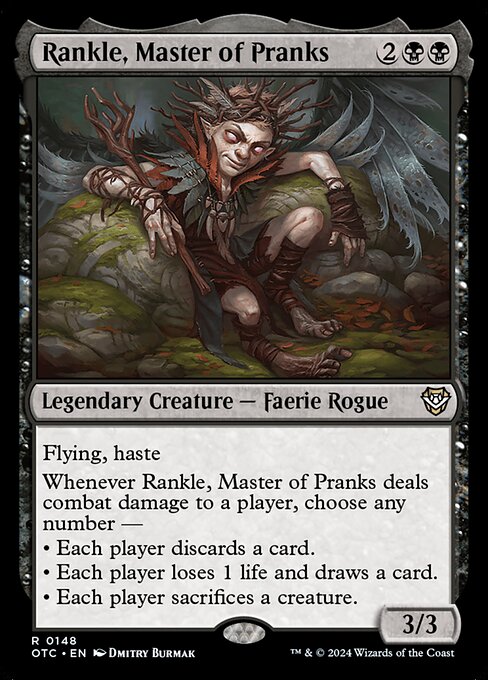
While it’s entirely possible Rankle earns their place in the growingly crowded Black four-drop slot —and I believe they will—I’m unsure whether Rankle climbs all the way up to a Vintage power-level cube. A four mana 3/3 haste flier is certainly good, especially to surprise opposing planeswalkers; but the trigger will only happens when hitting your opponent. Snare Thopter isn’t the worst failstate, and on an empty board a big Stronghold Rats can do work against an opponent trying to achieve critical mass. But Rankle isn’t exactly the hardest creature to block, or the hardest creature to kill. So how do they line up against cards like Ravenous Chupacabra or Gonti, Lord of Luxury?
The symmetrical trigger must be adventageous for me to deem it powerful enough. The mutual discard plus mutual draw makes me want to be aggressively curving out, which slots Rankle perfectly alongside creatures like Gravecrawler and Bloodghast, Madness creatures like Anje’s Ravager or Voldaren Pariah, or even alongside cheap reanimation spells. Combine this with Blood Artist effects and repeatable token generation like Bitterblossom and now you’re getting full, sweet value.
In case it wasn’t clear, Rankle takes more building around than other Black four drops. So if you don’t support them, the other creatures will usually be better options. Don’t simply assume Rankle’s an auto-include into any Black deck. If, however, you make some adjustments and treat Rankle as a synergy card, they should be an excellent payoff. I wouldn’t be surprised if Rankle breathed some life into the Blaggro (that’s Black Aggro) archetype, and provided drafters with a different axis on which to abusive those cheap reanimation cards.
Test this in every cube that’ll allow it. I know I will, as Black doesn’t get such unique creatures like this all that often.
The Cauldron of Eternity

This card reads like a slow, expensive reanimation spell. If you have five creatures in your graveyard, this is “2BBB, Pay 2 life: Reanimate.” So, assuming the game is going very long, or you have a way to self-mill your library, four to five creatures feels realistic, and Cauldron has some play to it. In any other scenario this feels far too glacial to make work.
Perhaps in a low power-level cube this can be a win condition, as the amount of value you can get from enter-the-battlefield effects and a renewed board presence should be enough to end the game. However, avoid this card in any high power environment. It’s simply too slow.
Syr Konrad, the Grim
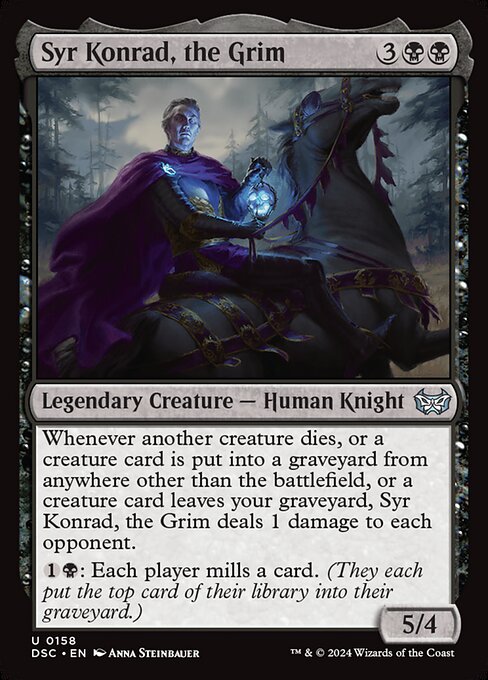
Limited mythic uncommon Syr Konrad is at home in Peasant environments with a heavily supported sacrifice theme. The sheer number of triggers available once he’s on the battlefield alongside cards like Cartel Aristocrat and Zulaport Cutthroat are staggering. If you’ve had the pleasure of playing with him in draft, you know what i’m talking about. Left unchecked Konrad can grind out almost anyone, provided you are entering combat, which isn’t all that hard. And once the game stalls out, his activated ability will kill very quickly.
That all being said, there’s no place for him outside of Peasant cube, where I expect him to flourish as a powerful finisher.
Clackbridge Troll
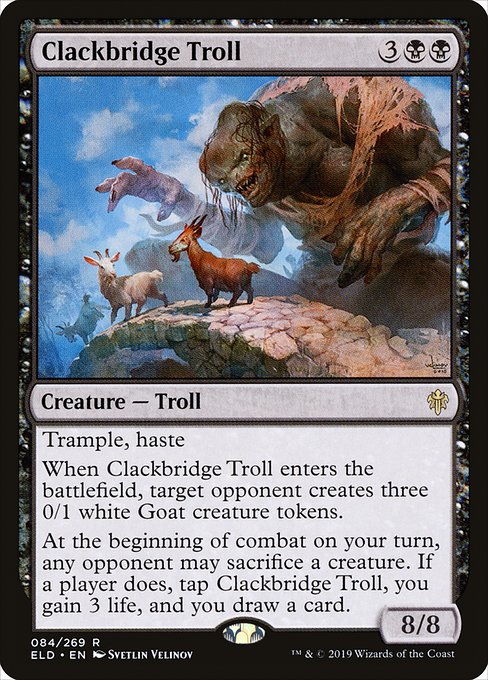
Similar in design to cards past like Desecration Demon, our newest hungry demon might not have wings but hits very hard. Unlike the demon, our friend the troll doesn’t mind giving you a very real bonus for your opponents sacrifice. Gaining three and drawing a card for three turns ain’t bad, and you do get your card back almost immediately. If your cube is a Modern or Low power environment, I can absolutely see this card providing enough of an advantage to be playable. Anything above that, and—sadly—we just don’t have time for a hungry troll.
Murderous Rider
Swift End is the second-best planeswalker removal spell ever printed. And now you’re telling me I get a halfway decent creature attached to it? Yep. This card is the real deal. A solid two-for-one that’s playable in any Black deck. I don’t think I need to say anything about this card. If your cube will allow it, you now have a new staple going forward. There’s nothing more to say except, thank you!
Piper of the Swarm
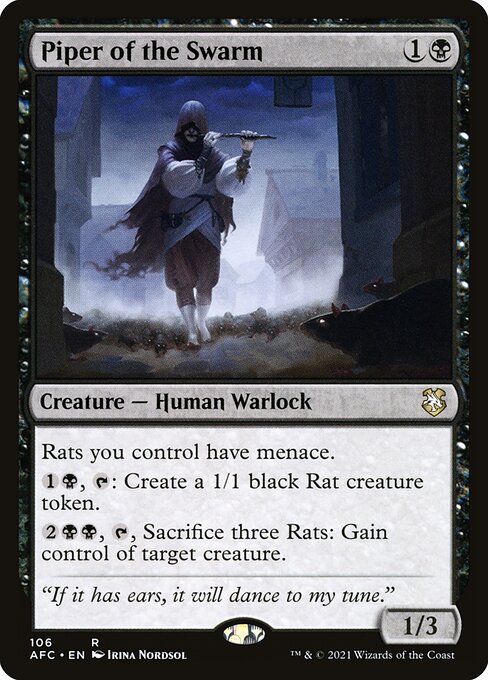
Most cube owners will remember the first time they pulled up the card database looking, for the second time, at the creatures available in Black for two mana. Looking over Piper of the Swarm initially, i’m sure I wasn’t the only one who sitrred a bit, hoping for something that could invigorate our tired searching for The Next Great Black Two Drop.
Sadly, I think Piper comes up a bit flat to be playable. They’re simply too slow. Maybe . . . maybe if you have a handful of those rats from Kamigawa black, and then you have Pack Rat, and then . . . nah. This just doesn’t get me going. Don’t test this card unless you’re interested in disappointment.
Wishclaw Talisman
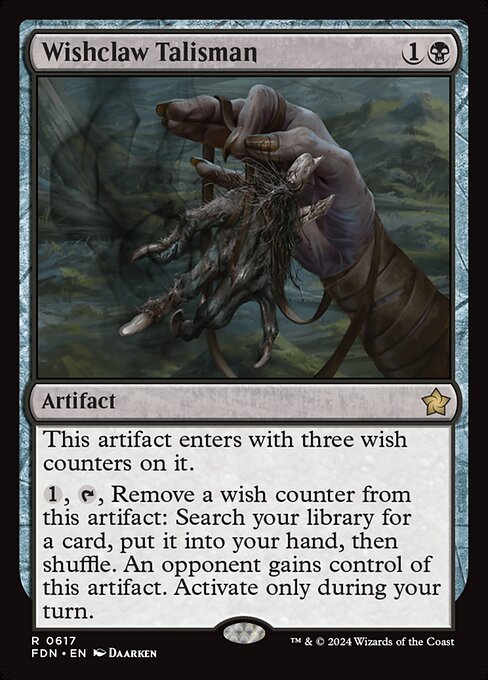
“We have so many tutors in Black already. Do we really need another one?”
Yes. Yes we do. This card is exciting for powered cubes. Paying for this effect in installments is a huge boon for combo decks, so don’t underestimate that. Cast this early, and you can save the tutor for when you need to go off, spending only one mana instead of two or three. This is easier to cast than Grim Tutor and you don’t lose any life in doing so, which already should be enough to warrant the Talisman’s inclusion.
Yes, the downside can be problematic in some matchups, as it’s easy to be interacted with once on the battlefield; so be prepared to win on the spot, or have a way to grab the Talisman back to your side of the table. Getting cards like Dack Fayden or Teferi, Time Raveler is an underrated “fair” usage of the talisman, so I expect it to show up in Legacy and even some Modern environments where tutoring is allowed.
I’m excited to see this in Vintage cube lists, and I hope it’s availble to draft during the holiday cube next month, and going forward.
Cauldron’s Gift
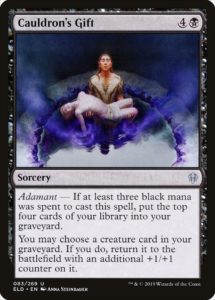
Recently we got Bond of Revival with War of the Spark. Cauldron’s Gift is similar, but instead of haste we get a bit of self mill (and a minor bonus to the creature, but whatever) tacked on. This Adamant clause makes me much more interested than its predecessor for low-power and Peasant environments.
Being able to spike a better reanimation target is an advantage, sure; but when your cube can support powerful endgame spells like Spider Spawning, you’ve got a combination of power and synergy that i’m excited to test. Five mana is a lot, so don’t expect this to be the gift that keeps on giving you wins; but it should have a place alongside Scavenge, Delve, Unearth, and Flashback shenanigans.
Foulmire Knight
Our next adventure creature is simple and elegant. While Foulmire Knight itself is just another Typhoid Rats, this little zombie has gone on a trip to glean some insights. At four mana, we have a (much less powerful) Baleful Strix.
As i’ve stated with the other adventure creatures, the flexibility is really what gives them legs. Profane Insight turns the worst part of a one mana 1/1 deathtouch creature from a liability to a bit of a freeroll. I expect this card to be tested and played in all Peasant cubes and most low power formats. We don’t need Edgewall Innkeeper or Lucky Clover to feel like we’ve gotten our value here.
Order of Midnight
Is this card better than Gravedigger? The more I play with Order of Midnight I think so, and i’m convinced this might be the new Black two-drop we’ve been looking for. Cast this on curve and Order of Midnight is about the same power level as Fledgling Djinn. Draw this late and you’ve got a serious piece of value with Alter Fate attached.
While Order of Midnight isn’t a windmill slam dunk into every cube environment, I think any cube that wants any amount of grinding out value and incremental advantage—Peasant is great, up to Modern power levels—will want this card in any deck that can cast it. Another exemplary adventure creature, another piece of evidence we might be in the new Golden Age of cube design.
Revenge of Ravens

Limited “Bomb” Ravenge of Ravens is interesting. At four mana, you’re taking an entire turn off to set up this slow, albeit resilient piece of creature control. While it can singlehandedly be lights-out for a token or go-wide strategy, it will more often than not have an annoying, but easy to overcome effect on the game.
For Peasant cubes, this could be an interesting inclusion into an Orzhov lifegain strategy, or even be a powerful sideboard card when the matchup is right. I’d be happy to test it in Peasant environments, but nothing above it.
Forever Young
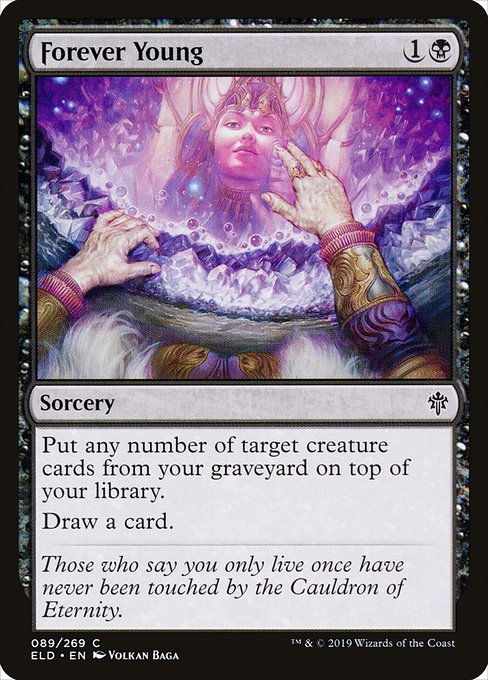
There have been several printings of similar effects like Forever Young, but none of them have been as cheap. The failcase isn’t all that bad, cycling it on turn two, and on average it’s a two-mana Raise Dead. These alone are far from justifying Forever Young as an inclusion in any cube environment.
The best case scenario of “stacking your deck” with the remains of a long battle? That’s cool, and somewhat powerful if the environment is slow enough. But I’d advise against testing this in anything save for a heavy graveyard themed cube, or something similar.
Power Rankings—Black
High Power
Low Power
Peasant
Blacks centerpiece, Murderous Rider, is the signpost adventure creature of the set, and will be the most ubiquitously adopted from this list. Otherwise we get an excellent two drop and some really unique spells at all power levels. I’m really happy with what Throne of Eldraine contributes to Black.
Thanks for reading! Next week we take a look at Red.

